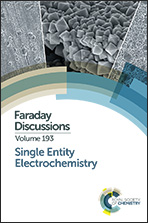Energetics of base flipping at a DNA mismatch site confined at the latch constriction of α-hemolysin†
Abstract
Unique, two-state modulating current signatures are observed when a cytosine–cytosine mismatch pair is confined at the 2.4 nm latch constriction of the α-hemolysin (αHL) nanopore. We have previously speculated that the modulation is due to base flipping at the mismatch site. Base flipping is a biologically significant mechanism in which a single base is rotated out of the DNA helical stack by 180°. It is the mechanism by which enzymes are able to access bases for repair operations without disturbing the global structure of the helix. Here, temperature dependent ion channel recordings of individual double-stranded DNA duplexes inside αHL are used to derive thermodynamic (ΔH, ΔS) and kinetic (EA) parameters for base flipping of a cytosine at an unstable cytosine–cytosine mismatch site. The measured activation energy for flipping a cytosine located at the latch of αHL out of the helix (18 ± 1 kcal mol−1) is comparable to that previously reported for base flipping at mismatch sites from NMR measurements and potential mean force calculations. We propose that the αHL nanopore is a useful tool for measuring conformational changes in dsDNA at the single molecule level.
- This article is part of the themed collection: Single Entity Electrochemistry

 Please wait while we load your content...
Please wait while we load your content...